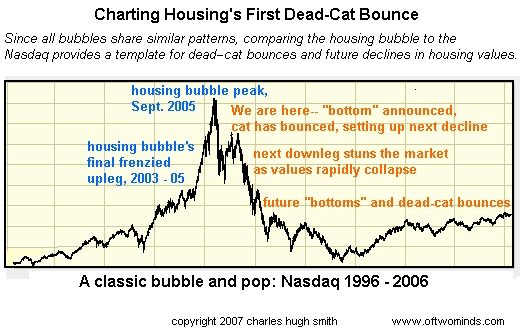

|
| weblog/wEssays archives | home | |
|
Charting Housing's First Dead-Cat Bounce (January 3, 2007) Question: How High Will a Dead Cat Bounce? Answer: Never high enough for those who bought near the top to recover their money. The "bottom" in housing has been called by a veritable army of self-serving analysts, and housing stocks have predictably shot up on this great "news." But rather than consider this superficial "news," let's look at the underlying patterns which all bubbles trace. 
Here is a chart of the Nasdaq stock market bubble, 1996-2006, which shares the general shape of the 1996-2005 housing bubble: a slow ramp up for a number of years, followed by a final two-year blow-out of skyrocketing valuations. After the peak is reached, then the first decline is brief, and a "recovery" takes hold. But the recovery--in stock market parlance, a dead-cat bounce--soon gives way to the forces underlying the bubble's deflation, and a much sharper and longer declines takes valuations to levels which were dismissed as "impossible" in the heady days of rising valuations. There are two big differences, of course, between the stock market and the housing market: liquidity and margin. The housing bubble's peaks and bottoms are far more gradual, more "saucer-shaped," if you will, than the stock market, for the simple reason that the stock market is highly liquid and housing is not. You can sell $400,000 of stock in a few seconds, while unloading a $400,000 house can take months. The other difference is margin calls. When you borrow money against your stock portfolio, it's called margin. This is the stock market equivalent (roughly) of a mortgage--money borrowed against equity. In the stock market, however, when your equity falls below 50% of your account value, then you have to sell off stock until your equity returns to at least 50%. You are not allowed, in other words, to wait until you have negative equity. Alas, there are no margin calls on home equity loans, so wishful-thinking speculators can hold onto their "investment" houses until their equity has shrunk to a negative number--the value of the house is less than the mortgage. One of the proximate causes of the 1929 stock market crash was very low margin requirements. At that time, the minimum equity for margin was only 10%, meaning you could leverage your cash ten-fold--in essence, buying a $100,000 investment for $10,000. Sound familiar? It should. It's just like a no-down or low-down mortgage on a house. High leverage works like magic on the way up: a $10,000 down payment on a $100,000 house nets a ten-fold return if the house rises to $200,000. But on the way down, the effect is reversed: a mere 10% decline in a $200,000 house purchased with a $20,000 down payment wipes out all the equity. A relatively modest 15% puts the owner in a negative equity hole with no hope of escape--the value is less than what they owe. So we can expect a "saucer-shaped" series of downlegs and dead-cat bounces in the housing bubble's deflation. Though the housing market won't exhibit the sharp spikes of the highly liquid stock market, the general characteristics of any bubble's pop are easily identified, regardless of the market or time. The first dead cat in the housing bubble's decline has bounced as high as it can, and the second leg down has started. Note: I am short TOL (Toll Brothers), meaning if the stock continues its decline I make money. If it shoots up to its old highs I am an idiot, i.e. I will lose money. This is not a recommendation, it is a disclosure. There is a difference. For more on this subject and a wide array of other topics, please visit my weblog. copyright © 2006 Charles Hugh Smith. All rights reserved in all media. I would be honored if you linked this wEssay to your site, or printed a copy for your own use. |
||
| weblog/wEssays | home |